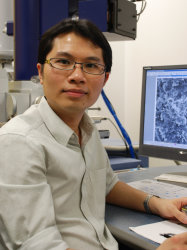Publications
114 results found
Wong HS, Zobel M, Buenfeld NR, et al., 2009, Influence of the interfacial transition zone and microcracking on the diffusivity, permeability and sorptivity of cement-based materials after drying, Mag. Concr. Res., Vol: 61, Pages: 571-589
Abdul Razak H, Wong HS, Chai HK, 2008, The potential of calcined Malaysian kaolin as a pozzolanic admixture for concrete, Malaysian Construction Research Journal, Vol: 3, Pages: 21-36
Head MK, Wong HS, Buenfeld NR, 2008, Characterising aggregate surface geometry in thin sections of mortar and concrete, Cem. Concr. Res., Vol: 38, Pages: 1227-1231
Lee HXD, Wong HS, Buenfeld NR, 2008, The potential of superabsorbent polymer for self-sealing cracks in concrete, 28th Cement and Concrete Science Conference
Wong HS, Buenfeld NR, 2007, Estimating the water/cement (w/c) ratio from the phase composition of hardened cement paste, 11th Euroseminar on Microscopy Applied to Building Materials, Pages: 113-114, ISSN: 0871-1607
Wong H S, Buenfeld N R, Hill J, et al., 2007, Mass transport properties of mature wasteform grouts, Adv Cem Res, Vol: 19, Pages: 35-46
Wong HS, 2006, Quantifying the pore structure of cement-based materials using backscattered electron microscopy
This thesis aims to develop backscattered electron microscopy and image analysis methods for accurate quantitative characterisation of the pore structure in cement-based materials, so that a better understanding of its nature and influence on molecular transport properties can be achieved.Phase segmentation is a crucial stage for image analysis. In order to accurately segment pores from a backscattered electron image, a new method called ‘Overflow’, is developed. ‘Overflow’ is found to be more objective and reliable than existing methods, requiring significantly fewer images to achieve statistical confidence.Quantitative electron microscopy at high-resolution requires consideration of the electron beam-sample interactions and the signal formation process in the electron micro-scope. For this, a Monte Carlo technique is used to simulate the electron-solid interactions in cement-based materials. This allows for the determination of the signal sampling volume, optimal imaging strategy and theoretical resolution limit for pore imaging.This thesis gives evidence that ‘patch microstructure’, a recently reported phenomena, is an artefact of sample preparation. An improved sample preparation method for back-scattered electron microscopy is proposed.A new image analysis tool that measures microstructural gradients at interfaces, at the highest possible resolution, has been developed. This method is based on Euclidean Distance Mapping, is more efficient than conventional methods and is unrestricted by feature geometry or boundary conditions. New information regarding the pore structure gradient at the interfacial transition zone is obtained, which may resolve the inconsistencies between experimental observation and computational modelling on the role of the interfacial transition zone in molecular transport.Mortar samples with a range of pore structure characteristics are prepared and tested for oxygen diffusion, oxygen permeation and water
Wong H S, Head M K, Buenfeld N R, 2006, Pore segmentation of cement-based materials from backscattered electron images, Cem Concr Res, Vol: 36, Pages: 1083-1090
Wong H S, Buenfeld N R, 2006, Monte Carlo simulation of electron-solid interactions in cement-based materials, Cem Concr Res, Vol: 36, Pages: 1076-1082
Wong HS, Head MK, Buenfeld NR, 2006, Characterising the pore structure of cement-based materials using backscattered electron and confocal microscopy, 16th European Conference on Fracture
Wong HS, Buenfeld NR, 2006, Patch microstructure in cement-based materials: Fact or artefact?, Cement and Concrete Research, Vol: 36, Pages: 990-997
Wong H S, Buenfeld N R, 2006, Euclidean Distance Mapping for computing microstructural gradients at interfaces in composite materials, Cem Concr Res, Vol: 36, Pages: 1091-1097
Wong H S, Buenfeld N R, Head M K, 2006, Estimating transport properties of mortars using image analysis on backscattered electron images, Cem Concr Res, Vol: 36, Pages: 1556-1566
Wong H S, Buenfeld N R, 2006, Reply to the discussion by Sidney Diamond of the paper 'Patch microstructure in cement-based materials: Fact or artefact?, Cem Concr Res, Vol: 36, Pages: 1002-1003
Buenfeld NR, Wong HS, 2005, Recent developments in backscattered electron imaging and image analysis of pores for predicting transport in concrete, Cementitious Materials as Model Porous Media: Nanostructure and Transport Processes
Wong HS, Buenfeld NR, Head MK, 2005, Estimating transport properties of mortars using image analysis on backscattered electron images, 10th Euroseminar on Microscopy Applied to Building Materials, Publisher: University of Paisley
Head MK, Wong HS, Buenfeld NR, 2005, Characterisation of "Hadley" grains by confocal microscopy, 10th Euroseminar on Microscopy Applied to Building Materials, Publisher: Elsevier Science, Pages: 1483-1489
Wong H S, Abdul Razak H, 2005, Efficiency of calcined kaolin and silica fume as cement replacement material for strength performance, Cem Concr Res, Vol: 35, Pages: 696-702
Abdul Razak H, Wong H S, 2005, Strength estimation model for high-strength concrete incorporating metakaolin and silica fume, Cem Concr Res, Vol: 34, Pages: 688-695
Abdul Razak H, Wong H S, 2004, Re-evaluation of strength and stiffness relationships for high-strength concrete, Asian Journal of Civil Engineering, Vol: 5, Pages: 85-99
Abdul Razak H, Chai H K, Wong H S, 2004, Strength and near surface characteristics of concrete containing supplementary cementitious materials, Cem. Concr. Comp., Vol: 26, Pages: 883-889
Abdul Razak H, Wong H S, 2003, A comparative assessment of silica fume and Malaysian kaolin as pozzolan for concrete, International Conference on the Performance of Construction Materials in the New Millenium: A New Era of Building
Abdul Razak H, Wong HS, 2001, Effect of incorporating metakaolin on fresh and hardened properties of concrete, Fifth CANMET/ACI International Conference on Recent Advances in Concrete Technology, Publisher: CANMET/ACI
Abdul Razak H, Wong H S, 2000, The use of an indigenous material as mineral admixture for high strength concrete, Conference of ASEAN Federation of Engineering Organization (CAFEO 18)
This data is extracted from the Web of Science and reproduced under a licence from Thomson Reuters. You may not copy or re-distribute this data in whole or in part without the written consent of the Science business of Thomson Reuters.

